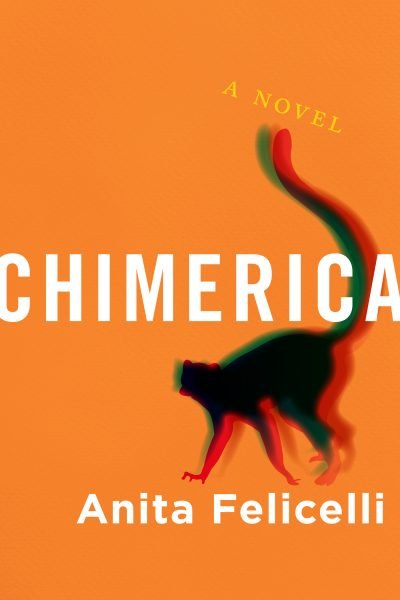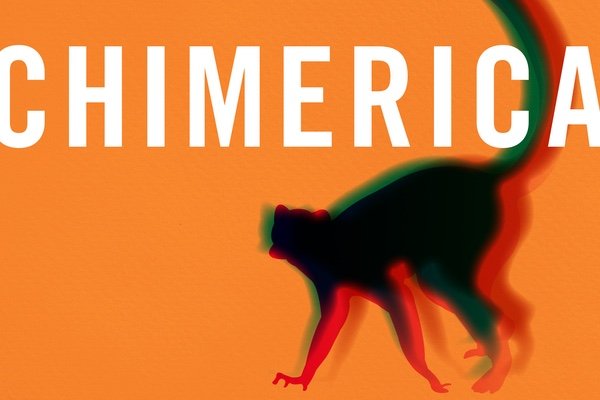Eye on the Indies:
A Look at Indie Authors and Their Publishers
By Lanie Tankard, Indie Book Review Editor
Chimerica by Anita Felicelli (Santa Rosa, CA: WTAW Press, September 5, 2019. 296 pages; $18.95; paperback ISBN 978-1-73298-201-7).
“The Lemur People are older than Homo Sap, much older.”
—William S. Burroughs,
Ghost of Chance

Anita Felicelli’s astute debut novel, Chimerica, is an intellectual treat that’s LOL witty and a page-turner to boot.
Oakland attorney Maya Ramesh has a giant lemur marching around her house. He’s munching on salt-and-vinegar potato chips because she’s out of salad greens (lemurs being herbivores). Maya’s prepping for a big copyright trial, but this lemur is homesick for Madagascar.
He climbed out of a painted trompe l’oeil mural downtown, which is why the celebrity artist sued the building owners for defacement of his creation—which is Maya’s legal case, or at least it was. She’s no longer welcome in her law firm. Her lover works there, too, but suddenly he’s gone as well. And what’s her doppelgänger up to, this lookalike Maya’s been glimpsing?
To complicate matters even more, Maya’s husband has left—took the kids and rented an apartment in Berkeley. “That law firm changed you,” he told his wife. Now this cheeky lemur is demanding a flight out of SFO today, and wants Maya to take him home. He is one intelligent prosimian. While Maya ponders the best course of action over a glass of wine, the lemur teaches himself to work the video game console with his opposable thumbs. As he crashes cars into concrete walls on the screen, Maya watches, noticing how human he looks. He’s a pretty big guy—the largest type of lemur called an indri, also known as babakoto (meaning “Ancestor of Man”). An indri stands upright, resembling humans in many ways.
Felicelli effectively brings many lemur traits to bear on her plot. The way she humanizes this particular indri is nothing short of brilliant. We simply accept that he can speak English fluently and colloquially. He’s a quick learner and wants to assimilate: “Can you set me up a Twitter account?” He’s not a narrator per se, but rather a pundit on many issues as they arise in the novel, directing the convo to salient points. And he has strong opinions on certain matters, such as genetics and cloning, the importance of biodiversity, and the blind faith humans place in internet search engines—to list but a few. Keeping the lemur unnamed allows him to become a metaphor representing the voiceless.
Chimerica, the book title, is an interesting combo of chimera (something existing only in imagination and not possible in reality) and America. As author Maria Semple did in her novel Where’d You Go, Bernadette, Felicelli unfolds the story not only through Maya’s first-person voice but also via texts, emails, postcards, chatrooms, mythology, letters, blog posts, and newspaper articles. She divides the tale into three parts: Origins, Mutation, and Return—prefacing each with spot-on quotations from Joy Williams, Blaise Pascal, and Maurice Sendak.
The novel takes place mainly in the Bay Area of California as well as a Madagascar rainforest. Flashbacks and legends about the Tamil Nadu state of India also appear. Lemurs are almost nonexistent characters in literature, but one is Ghost in the slender 1991 novella Ghost of Chance by William S. Burroughs, set in Madagascar.
Felicelli’s story is a triple mashup of anthropomorphism, magic realism, and surrealism—techniques that work well together to frame complex concepts in a readable way and generate suspense. The author goes into copyright infringement of artistic works, bringing in the Visual Artists Rights Act (VARA) and the California Art Preservation Act, to address the ethics of remixing images into “appropriation art,” and also includes representational art and critical theory.
She offers insight to the voir dire jury selection process in crafting effective client narratives for trial. Is the lemur human in the eyes of the law? Felicelli brings awareness to the concept of nonhuman civil rights for animals, also termed speciesism, as in the Nonhuman Rights Project (NhRP). A 2017 article in Pacific Standard by Jane C. Hu titled “When Is an Animal a Legal Person?” offers a fascinating discussion of the idea.
And that’s not all. Felicelli delves into women’s rights: Maya says she never wanted to be “a powerless brown woman.” Felicelli dissects marriage and “dual-career couples,” touching on language, gender, and power á la sociolinguist Robin Lakoff. Felicelli considers relationships: maternal via Maya’s teenage daughter and younger son, sibling via Maya’s artist sister, and paternal via Maya’s father. Maya’s parents were Tamil immigrants. Her father’s now a well-known patent attorney in Palo Alto and her mother died when Maya was a little girl.

Photo by Amy Perl
Overall, though, Chimerica revolves around the relationship between Maya and the lemur, which deepens because both can relate to “the daily reminders that you don’t fit in.” What Felicelli does so intriguingly is pit creative artistic freedom á la Lewis Hyde’s The Gift (third edition just out, with a foreword by Margaret Atwood) against not only copyright infringement but also nonhuman legal rights as in the definition of personhood. The lemur lawsuit starts to resemble the creation versus evolution debate in the 1925 “Scopes Monkey Trial.” Ah, but can Maya control the media message?
All these thought-provoking issues could weigh a satiric plot down, but they don’t, and that’s due to Felicelli’s subtle dexterity as a writer. I read the book on a flight from AUS to SFO, and kept bursting into unbridled laughter at the absurd scenarios Felicelli devised for Maya and the lemur.
Anita Felicelli opens up so many current problems of exploitation, freedom, walls, loss of autonomy, illusions, and unrealizable dreams in Chimerica. There are compelling questions for America here—but there’s also an incredibly fun read for that next long flight. You just might find your inner lemur by the time the plane lands.
One hopes for more from this debut novelist. Encore!
Anita Felicelli is a critic, essayist, poet, and writer living in the San Francisco Bay Area. Her first fiction book was a short-story collection, Love Songs for a Lost Continent, which won the 2016 Mary Roberts Rinehart Award from Stillhouse Press. Her poetry collection, Letters to an Albatross, came out in 2010.
She has received a Puffin Foundation poetry grant, as well as Greater Bay Area Journalism Awards from the San Francisco Press Club in 2014 and 2015 for her column “India Currents.” Her stories, essays, reviews, and criticism have appeared in a variety of publications including several anthologies, and been nominated for Pushcart Prizes.
Felicelli holds a BA with honors in Rhetoric, English, and Interdisciplinary Studies (Visual Art) from UC Berkeley, where she also earned a JD from the School of Law. She was born in South India and has traveled extensively around the world.
Publisher: WTAW Press
 WTAW Press in Santa Rosa, California, derives its acronym from the national Why There Are Words Literary Reading Series, a program of the press. Editor-in-Chief and Publisher Peg Alford Pursell (whose work appears in WTP Vol. VII #7) founded the independent nonprofit WTAW Press in 2016, and the first titles came out the next year. She had started the reading series in Sausalito in 2010, expanding it in 2017 to “a national neighborhood of readings presenting voices that need to be heard” in seven more cities: New York City, Los Angeles, Austin, Pittsburgh, Portland, New Orleans, and Asheville.
WTAW Press in Santa Rosa, California, derives its acronym from the national Why There Are Words Literary Reading Series, a program of the press. Editor-in-Chief and Publisher Peg Alford Pursell (whose work appears in WTP Vol. VII #7) founded the independent nonprofit WTAW Press in 2016, and the first titles came out the next year. She had started the reading series in Sausalito in 2010, expanding it in 2017 to “a national neighborhood of readings presenting voices that need to be heard” in seven more cities: New York City, Los Angeles, Austin, Pittsburgh, Portland, New Orleans, and Asheville.
Pursell earned an MFA in Creative Writing from the Warren Wilson MFA Program for Writers. Her work has been published in Connotation Press, Waxwing, Scoundrel Time, The Los Angeles Review, Joyland, and other journals and anthologies—as well as nominated for Pushcart Prizes and the Best Microfiction. She’s been a finalist for the Flannery O’Connor Award for Short Fiction, and twice received a South Carolina Fiction Project Award. Her stories have been performed at Stories on Stage Sacramento and Stories on Stage Davis. She is a member of the San Francisco Writers Grotto.
Pursell’s most recent book, A Girl Goes into the Forest with seventy-eight hybrid stories and fables, came out in July from Dzanc Books. Another collection, Show Her a Flower, a Bird, a Shadow, was the 2017 Foreword Reviews Gold Winner for Literary Fiction, short-listed for the 2018 Eric Hoffer Book Award, and highlighted in a 2018 “5 Over 50” annual feature by Poets and Writers magazine.
WTAW Press publishes full-length books of prose—novels, memoirs, creative nonfiction, collections of stories and essays, hybrids—distributed by SPD (Small Press Distribution). WTAW does not publish how-to or self-help books, reference texts, young adult or children’s literature, or poetry. During annual open submissions, WTAW blind reads manuscripts and selects two for publication the following year, welcoming submissions from writers of all backgrounds and especially encouraging women, minorities, LGBTQ or nonbinary gender people, persons with disabilities, and other traditionally underrepresented groups.
WTAW states: “We want to publish books that show us more things on heaven and earth than we have dreamt of.”
Copyright 2019 Woven Tale Press LLC. All Rights Reserved

